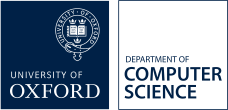Analysis II: Continuity and Differentiability: 2008-2009
Term | Hilary Term 2009 |
Overview
In this term's lectures we study continuity of functions of a real or complex variable, and differentiability of functions of a real variable.Learning outcomes
At the end of the course students will be able to apply limiting properties to describe and prove continuity and differentiability conditions for real and complex functions. They will be able to prove important theorems, such as the I.V.T., Rolle's and Mean Value, and will begin the study of power series and their convergence.Synopsis
Definition of the function limit. Examples and counter examples to illustrate when  (and when it doesn't). Definition of continuity of functions on subsets of
(and when it doesn't). Definition of continuity of functions on subsets of  and
and  in terms of
in terms of  and
and  . The algebra of continuous functions; examples, including polynomials. Continuous functions on closed bounded intervals: boundedness, maxima and minima, uniform continuity. Intermediate Value Theorem. Inverse Function Theorem for continuous strictly monotone functions. Sequences and series of functions. The uniform limit of a sequence of continuous functions is continuous. Weierstrass's M-test for uniformly convergent series of functions. Continuity of functions defined by power series. Definition of the derivative of a function of a real variable. Algebra of derivatives, examples to include polynomials and inverse functions. The derivative of a function defined by a power series is given by the derived series (proof not examinable). Vanishing of the derivative at a local maximum or minimum. Rolle's Theorem. Mean Value Theorem with simple applications: constant and monotone functions. Cauchy's (generalized) Mean Value Theorem and L'Hôpital's formula. Taylor's Theorem with remainder in Lagrange's form; examples of Taylor's Theorem to include the binomial expansion with arbitrary index.
. The algebra of continuous functions; examples, including polynomials. Continuous functions on closed bounded intervals: boundedness, maxima and minima, uniform continuity. Intermediate Value Theorem. Inverse Function Theorem for continuous strictly monotone functions. Sequences and series of functions. The uniform limit of a sequence of continuous functions is continuous. Weierstrass's M-test for uniformly convergent series of functions. Continuity of functions defined by power series. Definition of the derivative of a function of a real variable. Algebra of derivatives, examples to include polynomials and inverse functions. The derivative of a function defined by a power series is given by the derived series (proof not examinable). Vanishing of the derivative at a local maximum or minimum. Rolle's Theorem. Mean Value Theorem with simple applications: constant and monotone functions. Cauchy's (generalized) Mean Value Theorem and L'Hôpital's formula. Taylor's Theorem with remainder in Lagrange's form; examples of Taylor's Theorem to include the binomial expansion with arbitrary index.
Reading list
- Robert G. Bartle, Donald R. Sherbert, Introduction to Real Analysis (Wiley, Third Edition, 2000), Chapters 4-8.
- R. P. Burn, Numbers and Functions, Steps into Analysis (Cambridge University Press, 2000). [This is a book of problems and answers, a DIY course in analysis]. Chapters 6-9, 12.
- Walter Rudin, Principles of Mathematical Analysis (McGraw-Hill, 3rd edition, 1976). Chapters 4,5,7.
- J. M. Howie, Real Analysis (Springer Undergraduate Texts in Mathematics Series), ISBN 1-85233-314-6.
Alternative reading
- Mary Hart, A Guide to Analysis (MacMillan, 1990), Chapters 4,5.
- J. C. Burkill, A First Course in Mathematical Analysis (CUP, 1962), Chapters 3, 4, and 6.
- K. G. Binmore, Mathematical Analysis A Straightforward Approach, (CUP, second edition, 1990), Chapters 7-12, 14-16.
- Victor Bryant, Yet Another Introduction to Analysis (CUP, 1990), Chapters 3 and 4
- M. Spivak, Calculus (Publish or Perish, 3rd Edition, 1994), Part III.
- Brian S. Thomson, Judith B. Bruckner, Andrew M. Bruckner, Elementary Analysis (Prentice Hall, 2001), Chapters 5-10.
Taking our courses
This form is not to be used by students studying for a degree in the Department of Computer Science, or for Visiting Students who are registered for Computer Science courses
Other matriculated University of Oxford students who are interested in taking this, or other, courses in the Department of Computer Science, must complete this online form by 17.00 on Friday of 0th week of term in which the course is taught. Late requests, and requests sent by email, will not be considered. All requests must be approved by the relevant Computer Science departmental committee and can only be submitted using this form.
